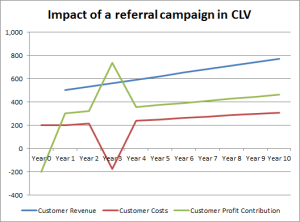Word-of-mouth delivers “free” new customers
As discussed in the article on word-of-mouth (WOM) benefits, leveraging customer referrals provides a good stream of new customers that come to the brand with a zero acquisition cost. This has three benefits for the firm:
- Its average new customer acquisition cost is reduced
- It may be able to reduce (or redirect) its promotional budget as a result
- Overall profitability of each customer is enhanced (that is, a higher CLV)
As we know, primarily due to the potential of social media to engage consumers, word-of-mouth has become a important priority for most marketers and has long been considered a reason why customers become more profitable over time.
How to calculate word-of-mouth in the customer lifetime value formula
The reduction of the acquisition cost per customer is a cost saving – it is NOT an increase in customer revenues (on a per customer basis). This cost savings is passed onto the company by being able to redirect or reduce their promotional expenses targeted at non-customers of the brand.
Therefore, to ensure that the customer lifetime value calculation (CLV) aligns of financial situation of the firm, it is appropriate to account for the word of mouth benefit as a cost saving – in other words, “negative” cost in the CLV formula, which how it is treated in the free Excel CLV template.
An example of incorporating WOM into CLV
To see how word-of-mouth (WOM) should be handled in the customer lifetime value calculation, let’s assume the following example for a brand:
- The average acquisition cost for a new customer has been calculated as $200
- The firm has been identified that 1,000 new customers were attracted during the year by referrals (word-of-mouth) from 500 existing customers. This means that each of these customers referred two new customers during the year.
The total acquisition cost saving for the brand is:
- 1,000 (new customers obtained through WOM) X
- $200 (average new customer acquisition cost) =
- $200,000 (total promotional “savings” – refer note below) /
- 500 (number of referring existing customers) =
- $400 (acquisition cost savings per referring customer)
This $400 cost saving would then be built into the appropriate year/s of the CLV calculation.
NOTE: The above promotional “savings” might not be in the form of a reduction in the marketing budget, but rather the ability to allocate the budget across more areas of marketing activities, which should lead to a more effective use of marketing funds.
Example of WOM in CLV in Graph Form
The following chart highlights the pattern of revenue/costs due to the inclusion of word-of-mouth acquisition cost savings in the customer lifetime value formula. As you can see, a major customer referral campaign was conducted by the firm in year 3. For that particular year, there is a reduction in customer costs – as the existing customers have “saved” money for the firm – which results in a jump in the per customer profit contribution for that year.
These customers are therefore more profitable because they have added to the firm by delivering new customers at a zero acquisition cost, allowing the firm to redirect its marketing budget into other areas of its growth programs.
Related Topics
Academic literature
For more information on handling word-of-mouth in the customer lifetime value calculation, please refer to this excellent academic article on WOM and acquisition cost savings.
